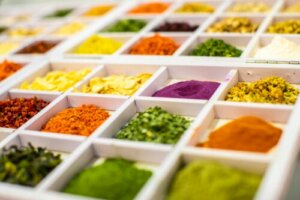How Food Colorants Affect Children's Health

Additives, such as food colorants, are substances that generate a lot of controversy among nutrition experts. Although some have been shown to be safe, others could negatively affect health in the medium term. For this reason, we’re going to tell you how dyes affect children’s health so that you can avoid them.
First of all, it’s important to emphasize the need to take care of the dietary pattern during all stages of life. If it guarantees an optimal supply of nutrients, the chances of developing some chronic and complex pathologies are reduced. In addition, laying the foundations for balanced nutrition during childhood is essential in order to maintain good habits in the future.
Are food colorants bad?

The first thing to be clear about is that not all colorants are the same, as this name includes a heterogeneous group of substances.
Some of them are of natural origins, such as curcumin that comes from turmeric. This has proven to be beneficial for health, as its consumption favors the prevention of chronic and complex illnesses.
On the other hand, other colorants are of industrial origin and could be dangerous for health in the medium term. In fact, many have already been withdrawn from the market because they increased the risk of cancer after consumption. And in this group are also tartrazine, cochineal red, and quinoline yellow, which are in the eye of the hurricane.
Specifically, the consumption of tartrazine is linked to teratogenic effects in animals, according to evidence published in the journal Toxicological Research. Although the results can’t be fully extrapolated to humans, experts suspect that this dye could induce epigenetic changes in our cells.
The problem of dye nomenclature
As you’ve seen, there are food colorants that can be beneficial, while others still raise doubts among the scientific community.
The main problem lies in the difficulties in interpreting product labels, as all colorants are described with an E followed by a certain number. The average consumer doesn’t know this code and, therefore, doesn’t know with certainty what type of additive they’re dealing with. This can lead to confusion and poor decision making when choosing food.
While food colorants of natural origin aren’t usually harmful to health, synthetics should be avoided whenever possible. Both in the diet of children and adults.
In this sense, the best strategy is to promote the consumption of fresh food and reduce the intake of ultra-processed industrial products. The former never contain additives inside, neither colorants nor preservatives. In fact, if you want to use an additive during cooking to improve the organoleptic characteristics of your meals, it’s best to use culinary spices.

Allergies to dyes
Finally, you should know that food colorants, like other additives, can cause allergic reactions in children.
Therefore, if alterations in the appearance of the skin, itching, swelling, difficulty breathing, or sore throat are detected after consuming a certain product, it’s essential that you go to the emergency center as soon as possible.
In a second instance, it’s crucial that you identify the allergenic substance that caused the reaction in order to avoid it in the future.
Reduce the presence of food colorants in the diet of children
The best thing for the health of children is to avoid the consumption of additives, both colorants and other artificial compounds.
In the case of opting for an element to improve the appearance of dishes, the most convenient options are culinary spices. These not only give food flavor but also provide antioxidants that help maintain good health.
Likewise, you need to promote good dietary habits from childhood, such as ensuring the presence of fresh food in the daily diet.
Additives, such as food colorants, are substances that generate a lot of controversy among nutrition experts. Although some have been shown to be safe, others could negatively affect health in the medium term. For this reason, we’re going to tell you how dyes affect children’s health so that you can avoid them.
First of all, it’s important to emphasize the need to take care of the dietary pattern during all stages of life. If it guarantees an optimal supply of nutrients, the chances of developing some chronic and complex pathologies are reduced. In addition, laying the foundations for balanced nutrition during childhood is essential in order to maintain good habits in the future.
Are food colorants bad?

The first thing to be clear about is that not all colorants are the same, as this name includes a heterogeneous group of substances.
Some of them are of natural origins, such as curcumin that comes from turmeric. This has proven to be beneficial for health, as its consumption favors the prevention of chronic and complex illnesses.
On the other hand, other colorants are of industrial origin and could be dangerous for health in the medium term. In fact, many have already been withdrawn from the market because they increased the risk of cancer after consumption. And in this group are also tartrazine, cochineal red, and quinoline yellow, which are in the eye of the hurricane.
Specifically, the consumption of tartrazine is linked to teratogenic effects in animals, according to evidence published in the journal Toxicological Research. Although the results can’t be fully extrapolated to humans, experts suspect that this dye could induce epigenetic changes in our cells.
The problem of dye nomenclature
As you’ve seen, there are food colorants that can be beneficial, while others still raise doubts among the scientific community.
The main problem lies in the difficulties in interpreting product labels, as all colorants are described with an E followed by a certain number. The average consumer doesn’t know this code and, therefore, doesn’t know with certainty what type of additive they’re dealing with. This can lead to confusion and poor decision making when choosing food.
While food colorants of natural origin aren’t usually harmful to health, synthetics should be avoided whenever possible. Both in the diet of children and adults.
In this sense, the best strategy is to promote the consumption of fresh food and reduce the intake of ultra-processed industrial products. The former never contain additives inside, neither colorants nor preservatives. In fact, if you want to use an additive during cooking to improve the organoleptic characteristics of your meals, it’s best to use culinary spices.

Allergies to dyes
Finally, you should know that food colorants, like other additives, can cause allergic reactions in children.
Therefore, if alterations in the appearance of the skin, itching, swelling, difficulty breathing, or sore throat are detected after consuming a certain product, it’s essential that you go to the emergency center as soon as possible.
In a second instance, it’s crucial that you identify the allergenic substance that caused the reaction in order to avoid it in the future.
Reduce the presence of food colorants in the diet of children
The best thing for the health of children is to avoid the consumption of additives, both colorants and other artificial compounds.
In the case of opting for an element to improve the appearance of dishes, the most convenient options are culinary spices. These not only give food flavor but also provide antioxidants that help maintain good health.
Likewise, you need to promote good dietary habits from childhood, such as ensuring the presence of fresh food in the daily diet.
All cited sources were thoroughly reviewed by our team to ensure their quality, reliability, currency, and validity. The bibliography of this article was considered reliable and of academic or scientific accuracy.
- Kocaadam, B., & Şanlier, N. (2017). Curcumin, an active component of turmeric (Curcuma longa), and its effects on health. Critical reviews in food science and nutrition, 57(13), 2889–2895. https://doi.org/10.1080/10408398.2015.1077195
- Hashem, M. M., Abd-Elhakim, Y. M., Abo-El-Sooud, K., & Eleiwa, M. (2019). Embryotoxic and Teratogenic Effects of Tartrazine in Rats. Toxicological research, 35(1), 75–81. https://doi.org/10.5487/TR.2019.35.1.075
This text is provided for informational purposes only and does not replace consultation with a professional. If in doubt, consult your specialist.








